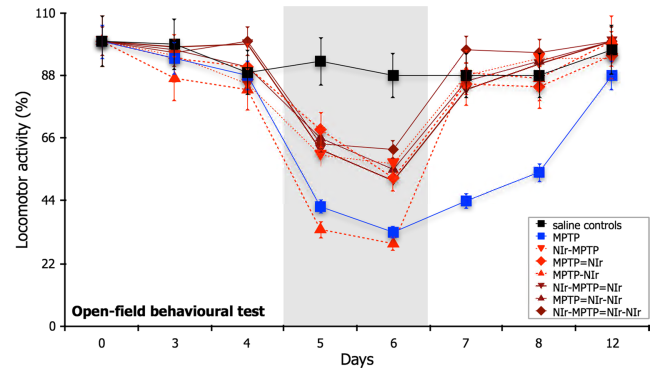Just 1 minute of red light is effective
-
Does anyone know how much the time would be affected by a 660nm light, versus a 670nm?
-
@LucH yeah, also idk about putting a high watt device on skin because of high EMF , maybe 1 foot away is ok if intensity stays high and short duration?
Ty looked into more of theirs, just 3 minutes into the eye of 8mw/cm2 (which they said is still more intensity than what sunlight gives at that 670nm red wavelength) boosted color vision for a week
https://www.researchgate.net/publication/356509034670nm for 2 minutes 40mw/cm2 daily every morning, didnt help reverse age related eye degeneration though https://www.researchgate.net/publication/340403571_A_Pilot_Study_Evaluating_the_Effects_of_670_nm_Photobiomodulation_in_Healthy_Ageing_and_Age-Related_Macular_Degeneration
but yellow + red + near IR (majority 670nm red) at 50 - 80mw/cm2, for 1 minute 30, for 3x a week for 3 weeks, gave a slight vision improvement https://pmc.ncbi.nlm.nih.gov/articles/PMC5484346/
so yeah 3x a week maybe better than daily
seems weird though because you'd be getting red light from the sun daily
30nm LED at just 3 mW/cm2 at skin level (created 1cm2 light spot on fifth ribs) improved LEF in heart failure mice
10 minutes 7 days a week for 1 week
https://pmc.ncbi.nlm.nih.gov/articles/PMC8674466/#s2
** extremely low intensity effective over day , 10.1159/000335547
freely moving under 0.042 mw/cm2 red light at surface for 12 hrs a day
showed improved stroke recovery when given for 20 days after induction
10.1007/s00221-016-4578-8
LED held over mouse head for 90 seconds in parkinsons x2 daily 3 hrs apart, effects lasted for 2 days after useWe have estimated the energy levels reaching the midbrain at 5.3 mW/cm2 SO I guess was at least ~50 mw/cmw at head level
NIr was fast-acting and long-lasting; behavioural improvements were almost immediate following treatment and lasted for several days thereafter.
preventative effect, and faster recovery to baseline (IMMEDIATE RECOVERY FROM A TOXIN)

It should be noted that in the MPTP-NIr (post-treatment) group, the locomotor activity of mice returned to baseline almost immediately after the first NIr treatment on 7d; in fact, these animals were moving more freely around their box within only 20 min after their NIr treatment. The activity of the mice in the MPTP group by contrast was still much lower than baseline over the 2 days post-MPTP injections (45–55 %)
(mptp-nir is delayed until day 7)
*{one group was given nir at same time or before only, and the recovery effect was still there 2 days after}
*We showed that NIr treatment was able to “protect” cells against a toxic insult and limit motor deficits both when applied immediately (within minutes; i.e. simultaneous-treatment) or when applied up to 2 days beforehand (i.e. pre-treatment)
Just 5 minutes a week (20mw/cm2) increased lifespan, bone size, cartilage amount in aged mice
https://www.sciencedirect.com/science/article/pii/S1011134424001179 -
@cs3000 Just one minute in the morning was enough to improve eye health in a study . It only worked in the morning as far as I remember. There seems to be something about red light in the morning being very healthy . Huber man talks about that a lot. It regulating circadian rhythms etc.
Red light also increases exercise recovery.
And it changes the micro biome in a beneficial way.Ray also said that after sunbathing shining red light on the hair (or skin) for a few seconds will prevent damage.
-
@cs3000 said in Just 1 minute of red light is effective:
Just 5 minutes a week (20mw/cm2) increased lifespan, bone size, cartilage amount in aged mice
https://www.sciencedirect.com/science/article/pii/S1011134424001179"The survival rate of treated SAMP8 mice was increased and their median lifespan was extended by >80% as compared to non-treated mice (Fig. 1C). "
That's pretty decent for a little bit of light. -
@cs3000 - Thanks, I like this thread. But my approach to eye health (in addition to red light) is to get a lot of lutein in my diet on a daily basis. See the thread https://bioenergetic.forum/topic/3281/is-lutein-a-magic-bullet-for-cognition?_=1732048163020
-
Pretty interesting, thanks for sharing.
I sometimes turn on my red light for many hours at a time in the winter with some idea of emulating sunlight... I actually did that yesterday and today I felt quite tired and my eyes were hurting.
Perhaps that is counterproductive.
-
@Mauritio said in Just 1 minute of red light is effective:
Just one minute in the morning was enough to improve eye health in a study . It only worked in the morning as far as I remember. There seems to be something about red light in the morning being very healthy
Some time ago, I posted about it on RPF here.
Below is that post screenshot as I don't know whether the link is generally usable.

-
is this done in combination to having an incandescent bulb? i remember hearing red light should be greater but needing the full spectrum.
-
@Lejeboca - Your screenshot works great. Glen Jeffery, University College London is the last named author in the image. He has been interviewed a number of times on YouTube. He has explained the there is nothing magical about the 670 wavelength; it was just the wavelength of the red LED bulbs that were commercially available at the time. I got the impression from the videos that his department operates on a shoestring budget.
The density of the mitochondria is greatest in the eye and it is their circadian rhythm that responds to the early morning light. Their response begin shortly before dawn and they do not respond well in the afternoon.
Full spectrum light of course would be the healthiest.
-
When we’re talking about reduced effectiveness from too much red/nir exposure, are we talking about actually reversing the benefit, or just wasting time
-
@castle said in Just 1 minute of red light is effective:
When we’re talking about reduced effectiveness from too much red/nir exposure, are we talking about actually reversing the benefit, or just wasting time
Probably depends on what benefits we are talking about.
From my own experience: Red-light exposure can be pretty stimulating and if I overdid it in the past, I would sometimes get some negative symptoms like fatigue or low blood sugar symptoms. I now treat it like a form of exercise. I make sure to have enough fuel in the system and I don't use it for more than ~ ten minutes a day, mostly less.
Some anecdotal evidence, since the effect on eye health was mentioned several times; I have used red light pretty regularly for almost 20 years now (back then for acne) and I never cared about the warnings not to look into it. I didn't shine it directly into the eyes intentionally, but I also never closed or covered them. And I'm the only one in my family, including extended family (aside from one cousin) who has good eyes and never needed glasses. Could have many reasons of course, but maybe the red light was a factor.
-
@Luke said in Just 1 minute of red light is effective:
almost 20 years now (back then for acne) and I never cared about the warnings not to look into it. I didn't shine it directly into the eyes intentionally, but I also never closed or covered them. And I'm the only one in my family, including extended family (aside from one cousin) who has good eyes and never needed glasses. Could have many reasons of course, but maybe the red light was a factor.
interesting. were you limiting your exposure all that time?
-
@castle said in Just 1 minute of red light is effective:
@Luke said in Just 1 minute of red light is effective:
almost 20 years now (back then for acne) and I never cared about the warnings not to look into it. I didn't shine it directly into the eyes intentionally, but I also never closed or covered them. And I'm the only one in my family, including extended family (aside from one cousin) who has good eyes and never needed glasses. Could have many reasons of course, but maybe the red light was a factor.
interesting. were you limiting your exposure all that time?
I never did more than 15 minutes a day or so, maximum 20. But I didn't limit it deliberately, I just didn't see the benefit in using it more.
-
 D DavidPS referenced this topic on
D DavidPS referenced this topic on